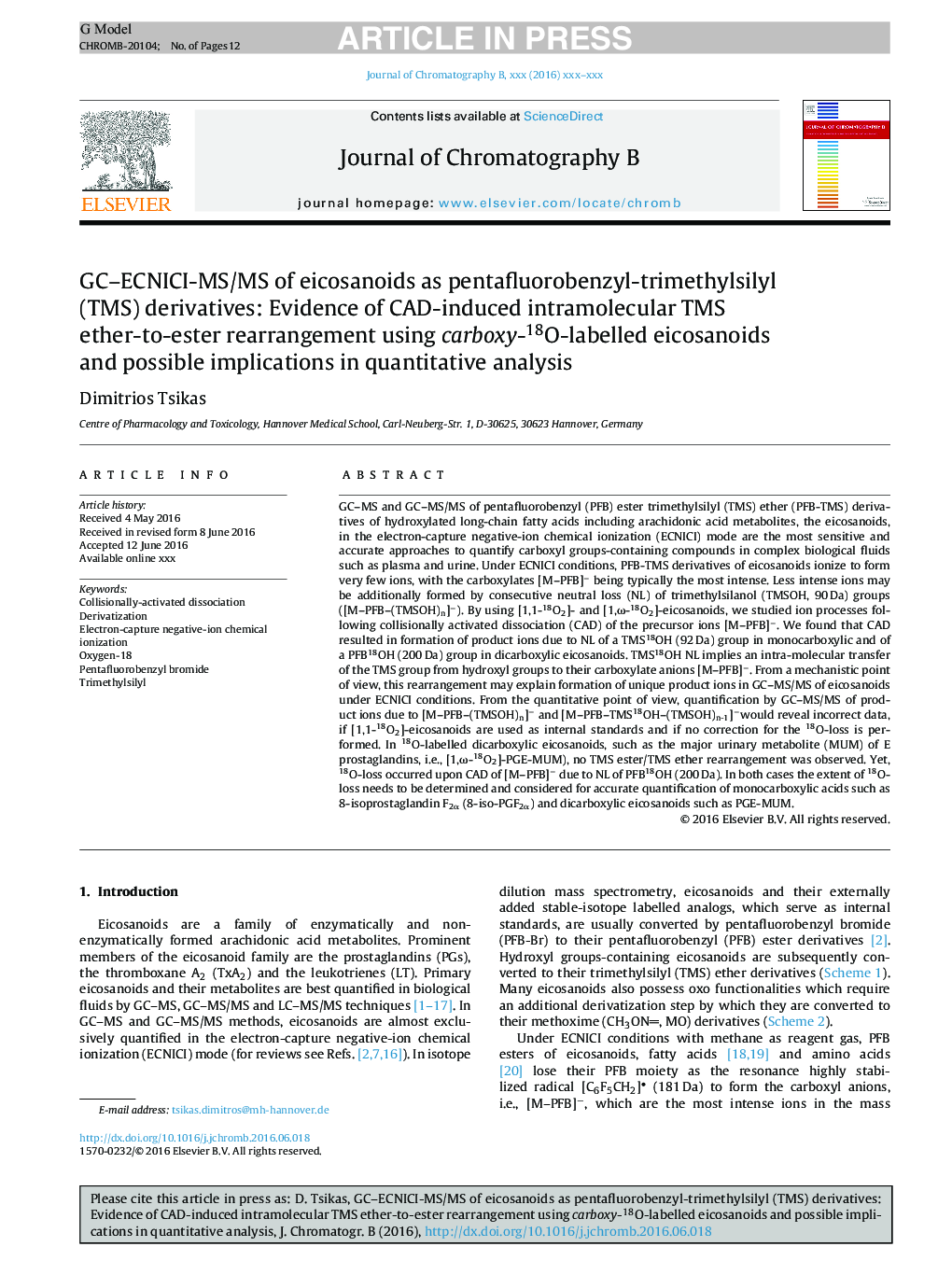| کد مقاله | کد نشریه | سال انتشار | مقاله انگلیسی | نسخه تمام متن |
|---|---|---|---|---|
| 5136770 | 1494014 | 2017 | 12 صفحه PDF | دانلود رایگان |
عنوان انگلیسی مقاله ISI
GC-ECNICI-MS/MS of eicosanoids as pentafluorobenzyl-trimethylsilyl (TMS) derivatives: Evidence of CAD-induced intramolecular TMS ether-to-ester rearrangement using carboxy-18O-labelled eicosanoids and possible implications in quantitative analysis
دانلود مقاله + سفارش ترجمه
دانلود مقاله ISI انگلیسی
رایگان برای ایرانیان
کلمات کلیدی
موضوعات مرتبط
مهندسی و علوم پایه
شیمی
شیمی آنالیزی یا شیمی تجزیه
پیش نمایش صفحه اول مقاله

چکیده انگلیسی
GC-MS and GC-MS/MS of pentafluorobenzyl (PFB) ester trimethylsilyl (TMS) ether (PFB-TMS) derivatives of hydroxylated long-chain fatty acids including arachidonic acid metabolites, the eicosanoids, in the electron-capture negative-ion chemical ionization (ECNICI) mode are the most sensitive and accurate approaches to quantify carboxyl groups-containing compounds in complex biological fluids such as plasma and urine. Under ECNICI conditions, PFB-TMS derivatives of eicosanoids ionize to form very few ions, with the carboxylates [M-PFB]â being typically the most intense. Less intense ions may be additionally formed by consecutive neutral loss (NL) of trimethylsilanol (TMSOH, 90 Da) groups ([M-PFB-(TMSOH)n]â). By using [1,1-18O2]- and [1,Ï-18O2]-eicosanoids, we studied ion processes following collisionally activated dissociation (CAD) of the precursor ions [M-PFB]â. We found that CAD resulted in formation of product ions due to NL of a TMS18OH (92 Da) group in monocarboxylic and of a PFB18OH (200 Da) group in dicarboxylic eicosanoids. TMS18OH NL implies an intra-molecular transfer of the TMS group from hydroxyl groups to their carboxylate anions [M-PFB]â. From a mechanistic point of view, this rearrangement may explain formation of unique product ions in GC-MS/MS of eicosanoids under ECNICI conditions. From the quantitative point of view, quantification by GC-MS/MS of product ions due to [M-PFB-(TMSOH)n]â and [M-PFB-TMS18OH-(TMSOH)n-1]âwould reveal incorrect data, if [1,1-18O2]-eicosanoids are used as internal standards and if no correction for the 18O-loss is performed. In 18O-labelled dicarboxylic eicosanoids, such as the major urinary metabolite (MUM) of E prostaglandins, i.e., [1,Ï-18O2]-PGE-MUM), no TMS ester/TMS ether rearrangement was observed. Yet, 18O-loss occurred upon CAD of [M-PFB]â due to NL of PFB18OH (200 Da). In both cases the extent of 18O-loss needs to be determined and considered for accurate quantification of monocarboxylic acids such as 8-isoprostaglandin F2α (8-iso-PGF2α) and dicarboxylic eicosanoids such as PGE-MUM.
ناشر
Database: Elsevier - ScienceDirect (ساینس دایرکت)
Journal: Journal of Chromatography B - Volume 1047, 15 March 2017, Pages 185-196
Journal: Journal of Chromatography B - Volume 1047, 15 March 2017, Pages 185-196
نویسندگان
Dimitrios Tsikas,